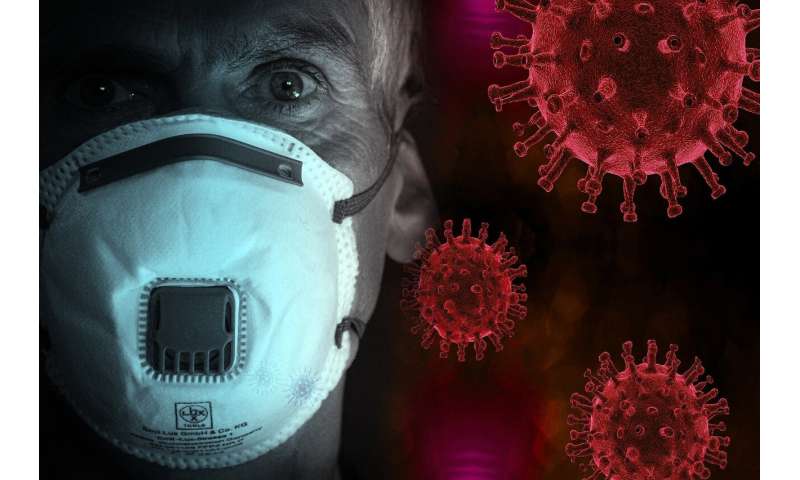
Even as others were dying of COVID-19, Rick Wright made phone calls to his business clients. He lifted weights, did pushups and glided on an elliptical trainer. Late at night, he took his dog on long walks.
“I never felt sick. Not a cough, wheezing, headache. Absolutely nothing,” said 63-year-old Wright of Redwood City, despite testing positive for the virus—40 days, straight—after being exposed aboard the Diamond Princess cruise last February.
Seven months into a pandemic that has killed more than 667,000 people globally, scientists are searching for clues into why infected people like Wright feel just fine.
Understanding the mystery of their protection may help suggest targets for vaccines and treatment. These cases also underscore the importance of masks and expanded testing, because asymptomatic people may unwittingly transmit infection to others.
The COVID-19 virus seems unprecedented in its spectrum of severity, from innocuous to lethal, said Dr. Anthony Fauci, director of the National Institutes of Allergy and Infectious Disease.
“Usually a virus that is good enough to kill you would make almost everybody at least a little bit sick,” he said, at this month’s first global COVID-19 Conference.
The nature of the pathogen itself does not seem to explain the person-to-person variability. Among families in the same household, infected by the same virus, people may get profoundly ill—or escape unscathed.
Nor does it seem to matter how much virus is circulating in the body.
Rather, emerging evidence suggests that a person’s immune response, largely influenced by genetics, is what helps determine the severity of illness, say infectious disease experts.
To capture our defenses in action, scientists with a UC San Francisco project are driving their van—outfitted with an exam table and a phlebotomy chair—to the homes of newly infected people, collecting samples of mucus, blood, urine and stool. They measure how the body responds as the virus gains a foothold.
“We’re able to look under the hood of what’s happening to the immune response,” said Dr. Sulggi Lee, a UCSF assistant professor of medicine and principal investigator of the CHIRP (COVID-19 Host Immune Response Pathogenesis) study. They’ve tested 17 people so far, but are aiming to recruit 60.
Estimates of the proportion of true asymptomatic cases—people who are infected and never develop symptoms as compared to people who are infected and later fall ill—have ranged from 40% to 45%, said UCSF epidemiologist Dr. George Rutherford. Those cases are challenging to identify because people feel healthy, so don’t get tested.
But the number could be far higher. During a recent testing blitz in San Francisco’s Mission District, where nearly 3,000 people were invited to get swabbed, sick or not, UCSF’s Dr. Carina Marquez and her team were startled to discover that 53% of people who tested positive had no fevers or coughs, muscle aches or severe fatigue. They breathed normally. They had a perfect sense of smell and taste.
Public health experts don’t know exactly how much spread is caused by asymptomatic people. But they suspect that it is a major driver of the pandemic.
To be sure, these infected people are not coughing and sneezing, symptoms which spread a lot of virus. But they are talking, and even singing. And while sick people stay home in bed, well people are out and about.
This week, a massive study of 32,480 staff and residents of Massachusetts elder care facilities found strikingly similar levels of virus in patients with—or without—symptoms.
Periodic testing of long-term residents, as well as routine testing and masking of staff, is needed to help reduce transmission, UCSF’s Dr. Monica Gandhi and her team wrote in the New England Journal of Medicine.
“Asymptomatic transmission of SARS-CoV-2 is the Achilles’ heel of COVID-19 pandemic control,” they concluded.
It’s well established that a person’s age and pre-existing medical conditions can make them more vulnerable to severe disease. People over the age of 65 or those with cardiovascular disease, diabetes and a history of smoking or obesity die at far higher numbers than younger and healthier people.
But the conditions that help infected people stay well are more elusive.
“It is still very early days, and there is little knowledge about immune responses in asymptomatic patients,” said Dr. Bali Pulendran, professor of pathology and of microbiology and immunology at Stanford University.
There are reports that suggest that the antibody response to the virus in asymptomatic individuals is weaker than in people with severe symptoms. That is contrary to earlier assumptions that healthier people make more antibodies to fight off the disease.
Perhaps other parts of the immune system—such as T cells, natural killer cells and myeloid cells—are kicking in quickly, holding the virus in check, said UCSF’s Lee.
What would make this early response so vigorous?
It’s possible the person has been exposed to other types of coronaviruses in the past, so they have so-called ‘cross reactivity.’ Because their T cells recognize the related COVID-19 virus, they are primed to fend it off, said Lee. This could help explain the reduced illness in children and residents of sub-Saharan Africa, with greater exposure to many viruses.
It’s also likely that genetics plays a role in the early immune response. Scientists are specifically interested in genes on human Chromosome 3, and whether mutations may predispose or protect someone from severe disease progression.
“What is unique about these people?” asked Lee. “We have to understand the whole range of what is happening.”
Source: Read Full Article
